How to Get Rid OfSnakes
40 min read Updated for March, 2019
Many people have a healthy dose of fear when it comes to snakes. And for good reason, they can be frightening creatures with dangerous, even deadly bites. You may not even know a snake is around until it’s too late.
Fortunately, encounters with snakes don’t happen often. And while it’s safe to say there isn’t a snake under every rock or pile of leaves, for most people, one encounter is too many.
40 min read Updated for March, 2019

Snake Sounds
We tend to think that snakes only hiss and rattle, but they actually have a few surprises we hadn’t considered: they can issue a growl (different pitches per species), some can shriek, and they fart! Some snakes, when cornered, will force air through vents in their back ends resulting in multiple popping sounds, aka flatulence. But more than not, you’ll either hear a snake rattling through leaves (making the sounds even without an actual rattler) or hissing.
Snake Tracks
Snake tracks aren’t overly obvious unless you’re looking for them, or the terrain allows for them. Sand, mud, dirt, and soil are the best receptors for tracks to be found. Snake tracks, while clearly taking a ‘slithering’ motion, will either take on a side-winding, side-pushing, lateral undulation, or a scrunch-up-scrunch-out motion called ‘concertina’. Straight line tracks are generally made by larger and heavier species of snake.
Snake Poop
Snake poop is pretty mushy and and smooth, and will often contain undigested portions of what they’ve eaten, including bones and fur. When fresh, snake poop is dark brown in color, but will turn chalky as it dries out. It comes out oblong shaped, with a white liquid excretion of urea. The size of the poop will specify the size of the snake, and its contents indicate which species you’re dealing with.
Identify
Common Species
There are more than 3,000 species of snakes worldwide, and you can find them on every continent, except Antarctica. Only about 50 species call the United States home. Below are the most common ones.
Venomous
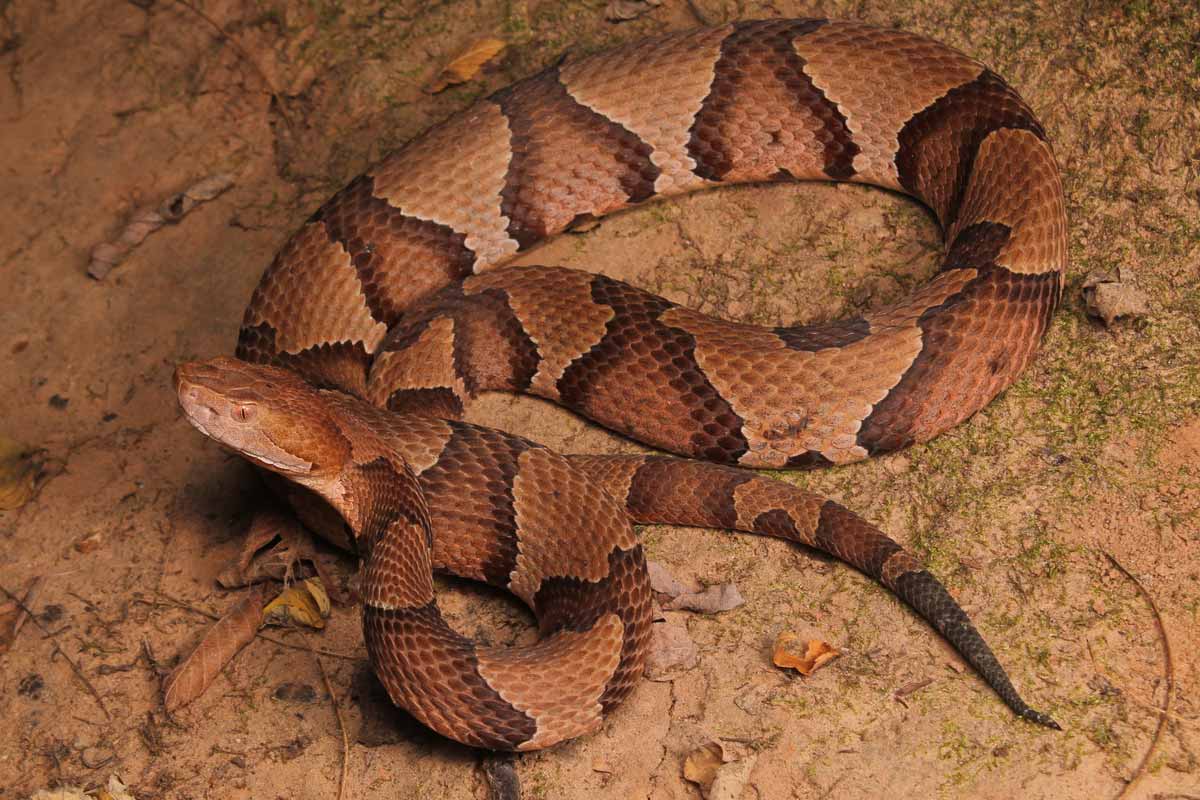
Copperhead
Appearance
- Reddish to golden tan bodies, copper-colored head
- Hourglass-shaped dark brown or reddish-brown crossbands, ridged scales
- Between two and three feet long, weighs about one pound
Behavior
- Found in the eastern United States to Texas
- Lives in forests, rocky areas, swamps, near water sources
- Eats mice, birds, lizards, frogs, salamanders, cicadas, caterpillars
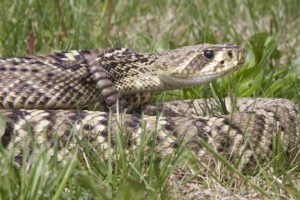
Rattle Snake
Appearance
- Largest venomous snake in the U.S. with size ranging from one to eight feet long, and weighing up to 35 pounds
- Black, gray bodies, well-defined black diamond patterns with yellow borders
- Triangular head, large fangs, rattling tail
Behavior
- Found in coastal Florida, lower southeastern U.S.
- Lives in pine forests, mountains, dry marsh
- Eats rabbits, rats, birds, lizards
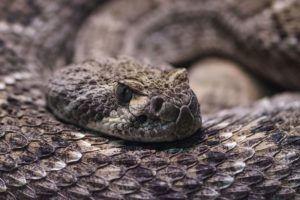
Rattle Snake
Appearance
- Four to five feet long, weighs up to ten pounds
- Brown, gray or pinkish bodies; dark diamond-shaped blotches, light-colored scales
- Spade-shaped head with a diagonal dark stripe on each side of the face; black, white banded, rattling tail
Behavior
- Found in Arizona, New Mexico, southern California, Texas
- Lives in deserts, salt marshes, rocky mountain areas
- Eats chipmunks, prairie dogs, gophers, ground squirrels, rabbits, mice, rats
Treating Your Property For Snakes
Snake Problem?
Timber rattlesnakes are three to four feet long, and weigh up to ten pounds.
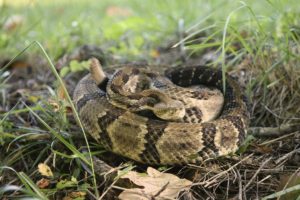
Timber Rattlesnake
Appearance
- Three to four feet long, weighs up to ten pounds
- Dark brown, yellowish or black bodies
- Triangular head, black rattling tail
Behavior
- Found in the northeastern United States, considered extinct in Maine, Rhode Island
- Lives in cane thickets, swamps, river floodplains, forests, mountainous and farming areas
- Eats rabbits, squirrels, rats, birds, lizards, frogs

Coral Snake
Appearance
- Between 20 and 30 inches long, weighs less than two pounds
- Slender red, yellow, black banded bodies
- Rounded heads, tails, noses, short fangs
Behavior
- Found in the southern part of United States
- Reclusive; lives in wooded, sandy, marshy areas; Hides in leaf piles, burrows in the ground
- Eats lizards, frogs, other small snakes
Water moccasins are between 50 and 55 inches long, and weigh three to four pounds.
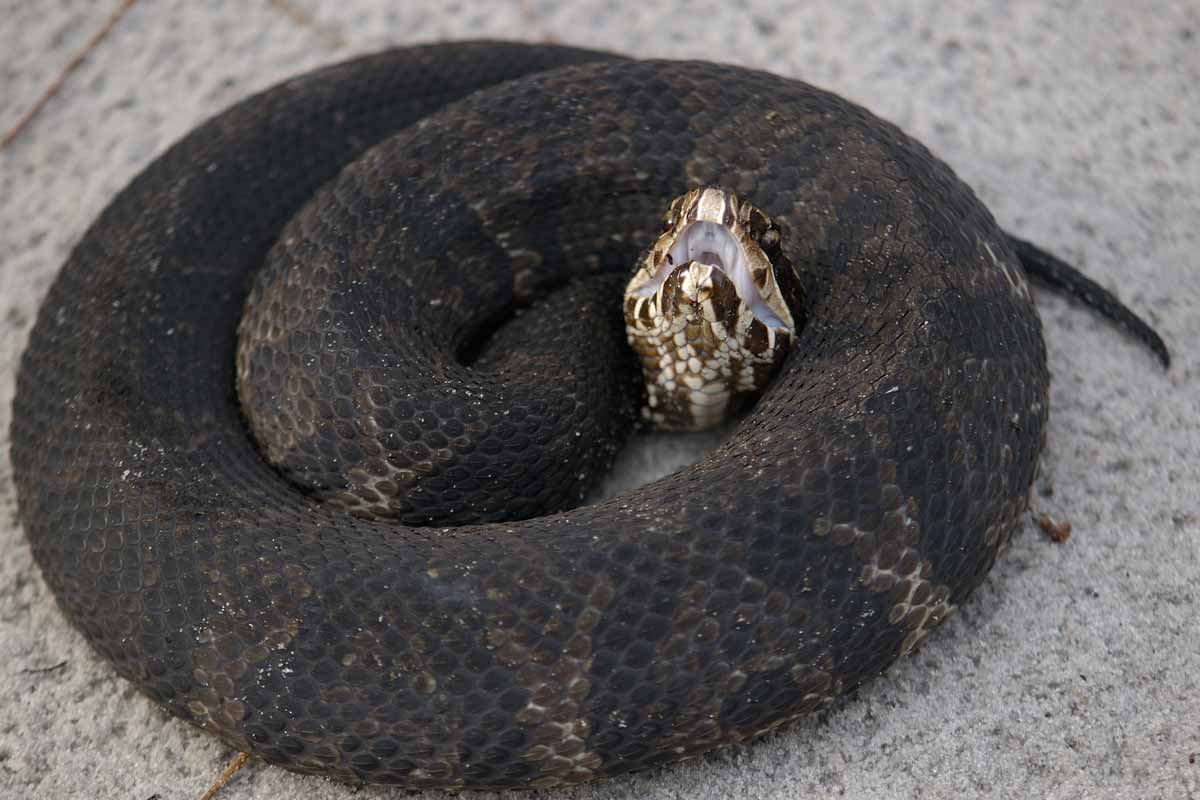
Water Moccasin or Cottonmouth Snake
Appearance
- Between 50 and 55 inches long, weighs three to four pounds
- Adults are dark tan, brown, black bodies with black or dark brown crossbands; Juveniles are bold brown or orange crossband, yellow tail
- Blocky, triangular head, thick, muscular bodies, vertical, cat-like pupils
Behavior
- Found in the southeastern United States
- Lives in rivers, lakes, other wetland areas; swims at the top of the water with head out
- Eats fish, birds, lizards, baby alligators, turtles, other snakes
Non-venomous
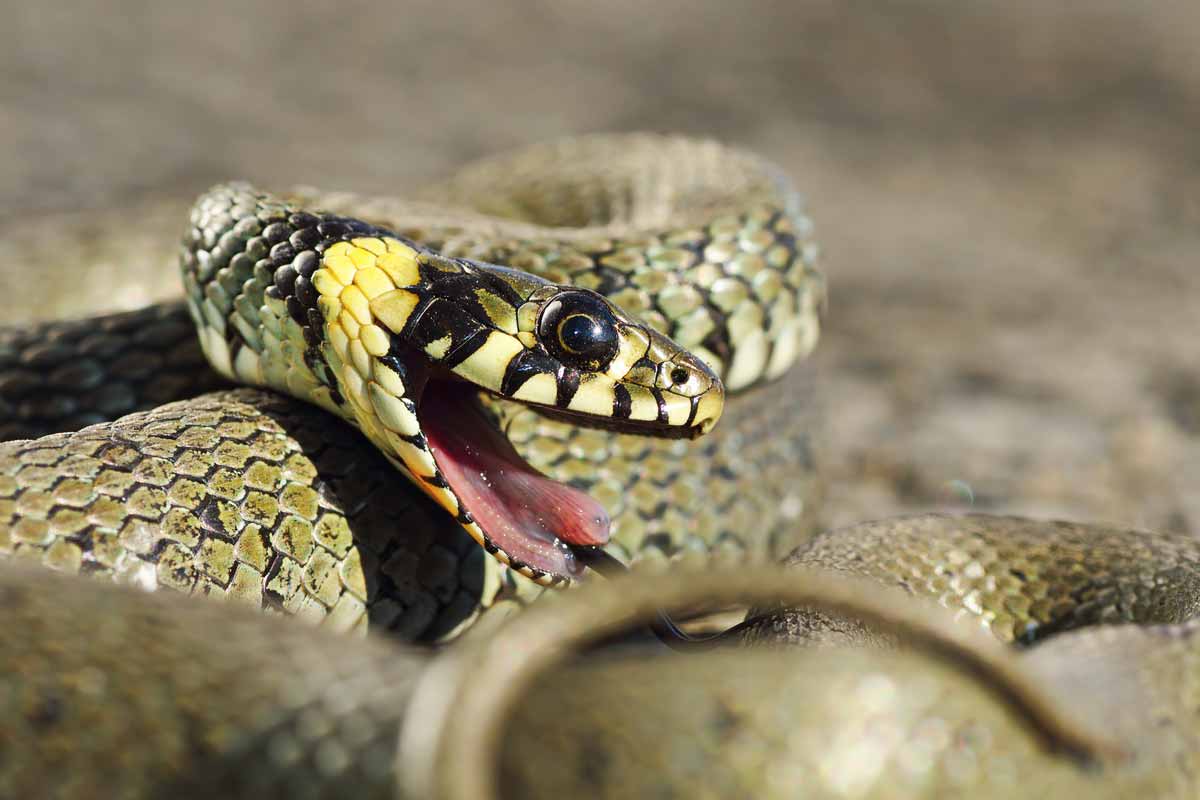
Garter Snake
Appearance
- Black, brown, gray or olive bodies; dark head wider than the neck
- Three white, yellow, blue, greenish or brown stripes run the length of the body
- Two to four feet long, weighs less than ten ounces
Behavior
- Found across the United States
- Lives near water in meadows, marshes, woodlands, hillsides
- Eats earthworms, leeches, slugs, snails, insects, crayfish, other snakes
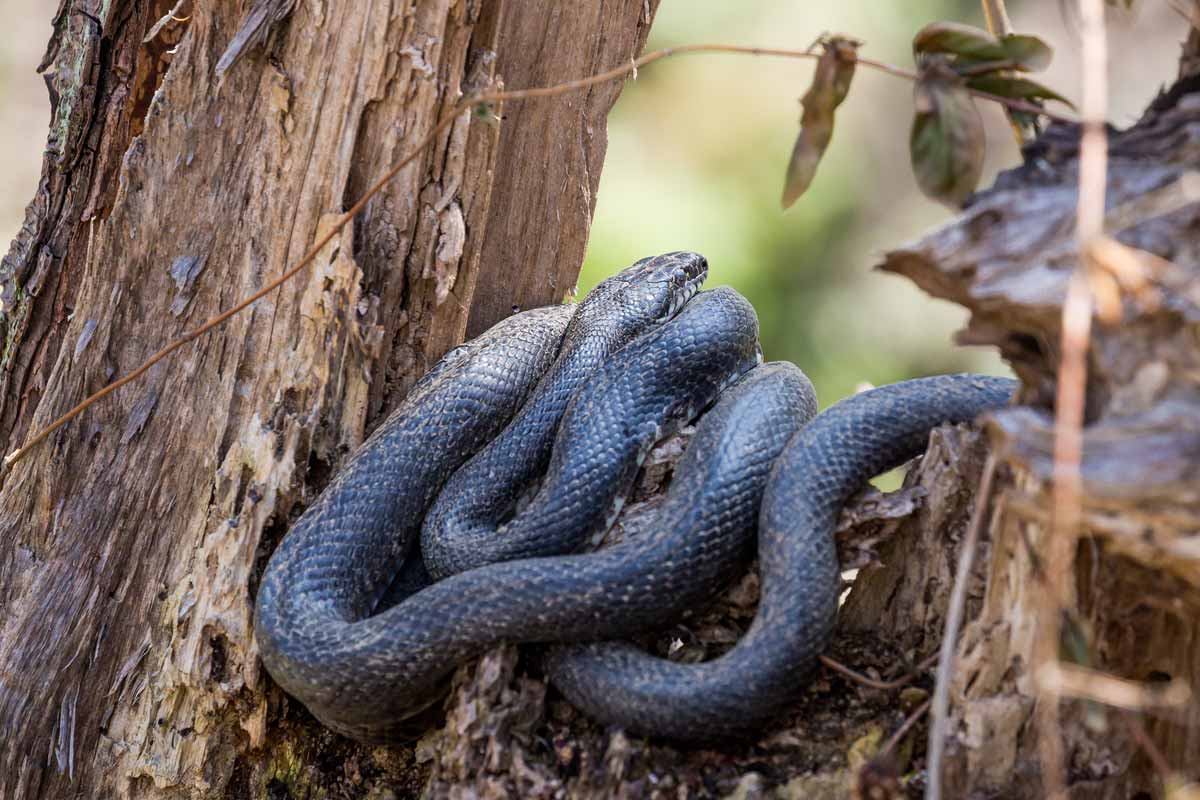
Rat Snake
Appearance
- Four to six feet long, weighs about two pounds
- Black, red, brown, yellow, gray or black and white bodies
- Wedge-shaped head, round pupils
Behavior
- Found across the United States
- Lives in forests, grasslands, cypress swamps, citrus groves
- Eats mice, rats, chipmunks, voles, frogs
Hognose snakes live in prairies, savannas, forests, woodlands; and prefer dry, loose soil.
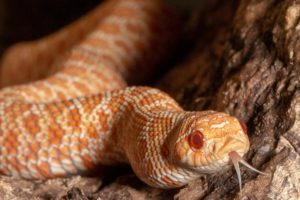
Hognose Snake
Appearance
- Two to four feet long, weighs two to four ounces
- Thick yellow, gray, brown, green or black bodies
- Rough scales, rectangular spots down the middle of the back
Behavior
- Found in most of the United States
- Lives in prairies, savannas, forests, woodlands; prefers dry, loose soil
- Eats toads, frogs, lizards, small birds
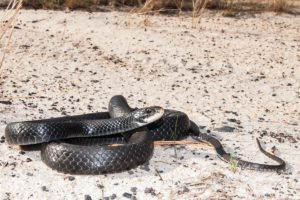
Black Racer Snake
Appearance
- Grows up to five feet long, weighs less than three pounds
- Slender, black bodies
- Smooth scales, large eyes, white under chin
Behavior
- Found in the eastern United States
- Lives in edges of forests and wetlands
- Eats insects, lizards, snakes, birds, rodents
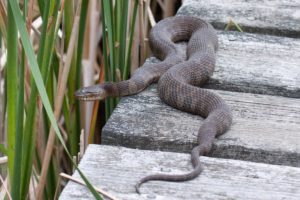
Water Snake
Appearance
- Between three and five feet long, weighs between five and 20 ounces
- Slender brown, gray, olive green or reddish bodies; dark splotches or bands on the back
- Slender, flat head, round eyes, rough scales
Behavior
- Found in the south and the eastern United States
- Lives in rivers, lakes, ponds, marshes
- Eats fish, frogs, toads, salamanders
There are several different species of rattlesnakes throughout the United States. The most common are the Eastern Diamondback, the Western Diamondback, and the Timber rattlesnake.
Common Locations
As much as you may fear them, snakes are good to have around. They help control the rodent population since they feed on rats, mice and a lot of other animals considered to be pests. And most of the time, you don’t even know they’re around because snakes prefer to stay out of sight and under cover.
Snakes are classified as cold-blooded reptiles and are closely related to lizards. Unlike lizards, snakes don’t have external ears or eyelids, and they don’t smell with their nose. They have a forked or split tongue they use to smell and taste chemical compositions in the air to figure out their surroundings. Instead of hearing, they feel vibrations through the ground to know what is going on around them.
Copperheads, cottonmouths, and rattlesnakes are pit-vipers, which means they have a pit near each nostril. It’s highly sensitive to heat and helps the snake locate warm-blooded prey.
There are several different species of rattlesnakes throughout the United States. The most common are the Eastern Diamondback, the Western Diamondback, and the Timber rattlesnake. Rattlesnakes are common across the United States, but the highest concentration of them is in the southwestern part of the U.S., particularly Arizona and New Mexico.
The southeast part of the United States is where you will find the Eastern Diamondback rattlesnake. The Pinelands of Florida, coastal plains of North Carolina, Mississippi and Louisiana is where this type of rattler calls home. They like to hang out in scrublands, coastal forests, barrier islands, and pine forests. You can also find them in overgrown fields or farmland that are no longer in use.
Eastern Diamondback snakes mate in the spring and fall. Females will give birth to between 12 and 24 babies in late summer but only reproduce every two or three years.
You can find Western Diamondback rattlesnakes in Arizona, California, New Mexico, Oklahoma, and Texas. It’s not picky when it comes to finding a home. Western Diamondbacks live in deserts, grassy plains, forests, rocky hills, and even along the coast.
Mating for Western Diamondbacks happens in the spring and females are three years old before they can reproduce. Females usually have between ten and 20 young at one time.
Timber rattlesnakes call the eastern half of the U.S. home. They can be found from the southern parts of Minnesota and New Hampshire all the way to Florida and as far west as Texas. You can find them in lowland cane thickets, rugged parts of forests, high areas of swamps, pine and hardwood forests, and on farmland. Timber rattlesnakes aren’t seen too often in urban or developed areas.
Female Timber rattlesnakes don’t start reproducing until they are five years old and usually wait two or three years between litters. Baby Timbers are born in late summer or early fall.
Cottonmouths or Water Moccasins choose to live in Alabama, Arkansas, Florida, Kentucky, Louisiana, Mississippi, North Carolina, South Carolina, Tennessee, Texas, and Virginia. You will find them most often in or near water—in marshes, swamps, ponds, lakes, ditches, and canals. Female cottonmouths can have litters with up to 20 babies, but only reproduce every two to three years.
The southern part of the United States is where you will find Coral snakes. It’s most prevalent in Florida but is scattered in southern coastal areas from North Carolina to Louisiana. Coral snakes live in areas with pine and scrub oak sandhills but can also like to live in hardwood forests. Coral snakes lay about six or seven eggs in early summer. The young hatch in late summer or early fall.
Copperheads can be found throughout the eastern and central parts of the United States, although you won’t find them in parts of Florida or Georgia. They live in forests, mountains, or rocky hillsides. Copperheads mate in the spring and the females give birth to between seven and ten babies at a time, but usually only reproduce every other year.
Garter snakes are common across the United States, most often in wet, open, grassy places. They like open fields near streams or ponds or near the edge of a wooded area. They are more tolerant of cold than a lot of other snakes and tend to hibernate in groups. You can often see them on warm days during the winter.
Rat snakes can live in every state in the Southeast, and most of the East and Midwest and have been spotted as far north as New England and Michigan. Their habitat of choice is in rocky, wooded hills, forests, river floodplains, and near swamps.
The eastern half of the United States from Florida to New England is where the Hognose snake calls home. They prefer to live in sandy soils, fields, farmland and coastal areas.
Black Racer snakes are found in the eastern part of the United States—from southern Maine to the Florida Keys. They can be found anywhere, but are most often in forest edges, fields and the edge of wetlands. You can also find them in agricultural areas.
Not to be confused with venomous Cottonmouths, water snakes live throughout the eastern and central portion of the United States. As their name implies, they like water and live in lakes, ponds, marshes, rivers, and streams.
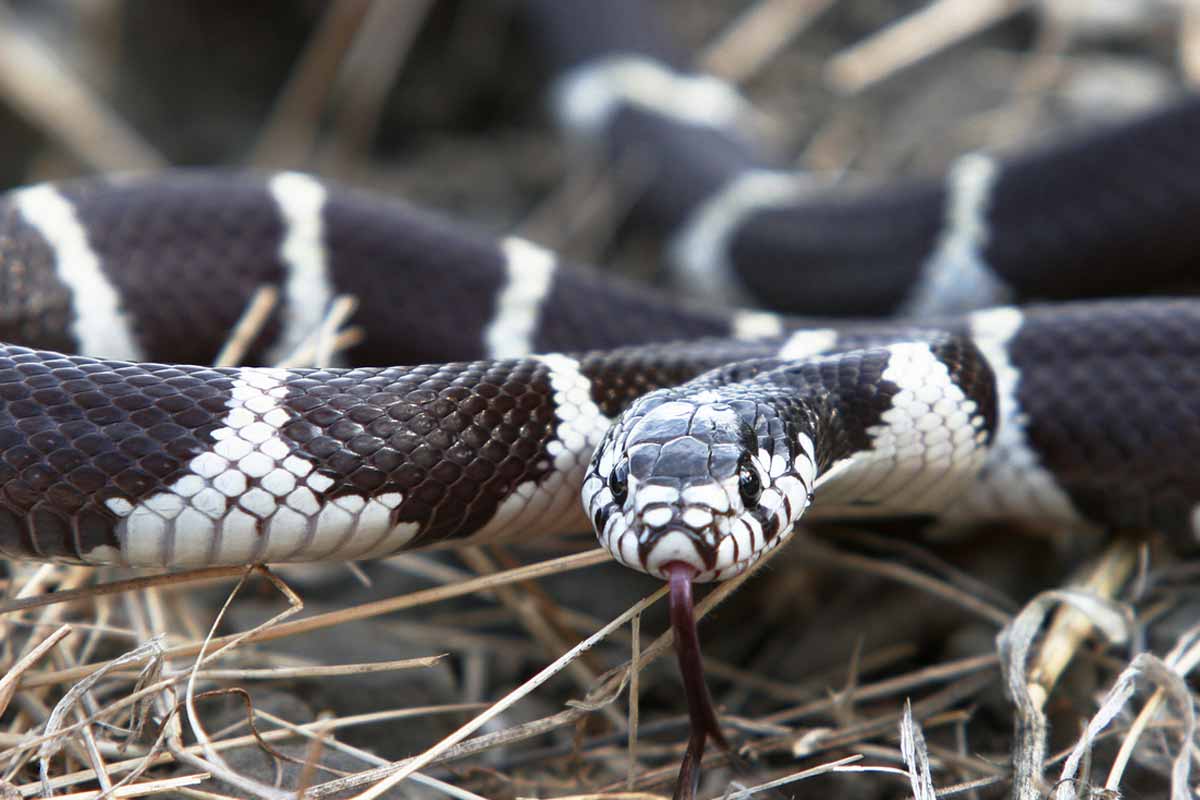
Snakes are cold-blooded creatures, so they don’t like the cold and are relatively inactive during the coldest parts of the year.
Why They’re Here
Snakes are cold-blooded creatures, so they don’t like the cold and are relatively inactive during the coldest parts of the year. They can’t regulate their body temperature like warm-blooded animals. If it’s cold outside, snakes will have to find some place warm. They will often hibernate in underground tunnels, but colder months will also send them slithering inside your garage, shed or home.
Eastern Diamondback rattlesnakes move around during the day, mostly in the morning or evening during the summer months. They spend winter in stump holes or tortoise burrows. Like most rattlers, Eastern Diamondbacks spend most of their time coiled in thick vegetation ready to ambush prey.
Western Diamondbacks spend the hot part of the day coiled up in shaded areas in shrubs, rocks, piles of natural or human-made debris or underground burrows of other animals. These rattlers hunt at night and spend winter hibernating in caves.
Western Diamondbacks stand their ground when threatened and bite more humans than any other venomous snake in the United States. Rattlesnakes can grow up to eight feet long and can accurately strike at up to one-third of their body length. Depending on the type of rattlesnake you encounter, that can be up to two feet away.
Timber rattlesnakes start becoming active above ground in late spring, and you will see them until late fall when the temperatures begin to dip. They hibernate during the winter months in dens of mountainous areas. They are active both day and night but spend most of their time coiled up ready to capture their next meal. Timber rattlesnakes are considered docile but will not hesitate to bite if they feel threatened.
Copperheads can sometimes co-exist in the same den with Timber Rattlesnakes. They adapt well to changes in habitat and are common in suburban areas of large cities. You can see them during the day or at night but usually they forage after dark during the hotter parts of the season. Copperheads are opportunistic feeders and can often be seen crossing roads during the evening hours.
Copperheads are responsible for most of the snake bites in the Southeast each year. Fortunately, deaths from copperhead bites are very rare, because their venom isn’t as potent as other pit vipers. They aren’t usually aggressive, but they will freeze when they are frightened. You are more than likely to be bitten by a copperhead if you unknowingly step on or near one. They have well-camouflaged bodies and will generally blend in with what’s around them.
Cottonmouths or Water Moccasins do not scare easily and will quickly defend themselves if they feel threatened. They open their mouth wide to show their fangs. The inside of their mouths is white, and that’s how they became known as cottonmouths. These snakes can be found day or night and can be found year-round on warm days. They prefer to hang out under logs, rocks or branches near the water.
Cottonmouths are considered opportunistic feeders, but generally feast on fish and small animals and can bite underwater. If they aren’t alarmed, cottonmouths swim with most of their body above the surface of the water. Swimmers, boaters, or anyone fishing in lakes or rivers should always be on the lookout for these snakes.
Coral snakes are secretive and spend most of their time underground, that’s why they are rarely seen. Sightings of them usually only occur during the spring and fall. They tend to burrow into the ground or hide in leaf piles and spend limited time above ground.
When they feel threatened, coral snakes will elevate themselves, curl the tip of their tail and make a popping sound. They are one of the most venomous snakes there is. For that reason, a rhyme was developed to identify a coral snake as soon as possible.
“Red and yellow, can kill a fellow.”
“Red and black, a friend of Jack.”
The rhyme implies if the red and yellow bands are beside each other, you have encountered a coral snake.
Garter snakes are non-venomous, but when cornered, they will flatten their head and body, coil up and strike. If you grab one, they will put off a foul musky odor. One way to identify a garter snake is by their tongue; it is red with a black tip. Garter snakes are active during the day, but in hot weather become nocturnal.
Rat snakes like to live where there is an abundance of mice or rats. You will often discover them in abandoned buildings and barns in suburban areas. Rat snakes are constrictors that can climb brick walls or tree trunks. They will kink their body and remain still if they feel frightened. They also vibrate their tail and release a very unpleasant musty smell.
You will generally only see Hognose snakes during the day and will find them in places where there are lots of toads since that’s their favorite food. When confronted, a Hognose snake will suck in air, spread the skin around its head and neck, hiss, lunge and pretend to strike, but it almost never bites. When it’s frightened, this snake will eventually roll on its back, open its mouth and play dead.
Black Racer snakes are only active during the day. You will see them the most in warm weather. They hide in burrows at night and in cooler weather. They are fast, agile snakes that generally take off quickly when approached.
Water snakes feed on fish, and you will often see them basking on the banks of rivers or ponds. But they can also be found lying on branches that hang over bodies of water.
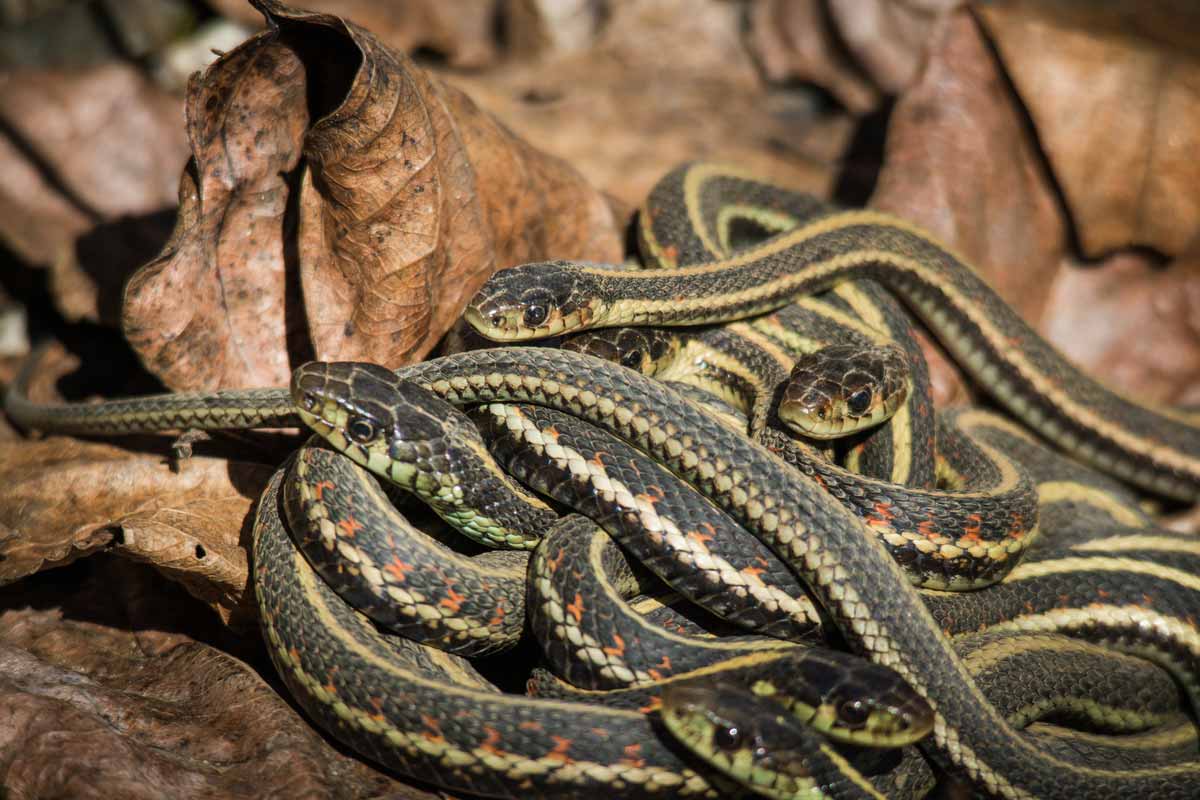
Snake Sounds
We tend to think that snakes only hiss and rattle, but they actually have a few surprises we hadn’t considered: they can issue a growl (different pitches per species), some can shriek, and they fart! Some snakes, when cornered, will force air through vents in their back ends resulting in multiple popping sounds, aka flatulence. But more than not, you’ll either hear a snake rattling through leaves (making the sounds even without an actual rattler) or hissing.
Snake Tracks
Snake tracks aren’t overly obvious unless you’re looking for them, or the terrain allows for them. Sand, mud, dirt, and soil are the best receptors for tracks to be found. Snake tracks, while clearly taking a ‘slithering’ motion, will either take on a side-winding, side-pushing, lateral undulation, or a scrunch-up-scrunch-out motion called ‘concertina’. Straight line tracks are generally made by larger and heavier species of snake.
Snake Poop
Snake poop is pretty mushy and and smooth, and will often contain undigested portions of what they’ve eaten, including bones and fur. When fresh, snake poop is dark brown in color, but will turn chalky as it dries out. It comes out oblong shaped, with a white liquid excretion of urea. The size of the poop will specify the size of the snake, and its contents indicate which species you’re dealing with.
Inspect
How Do I Know If Snakes Are Around My Home?
Most of the time you won’t know. Snakes tend to slither right through without bothering anything. They keep to themselves and don’t strike unless they feel threatened. That said, you still don’t want an infestation. An excellent way to keep snakes away from your property is to keep other rodents away, rats and mice in particular. (maybe link to he how to get rid of rats and mice articles here?)
There are a few signs to look for if you think a snake is living on your property. Snakes shed their skins—sometimes up to three times a year. So, look for skins around your property if you are concerned. They also will leave winding trails on dirty or sandy surfaces as they slither away.
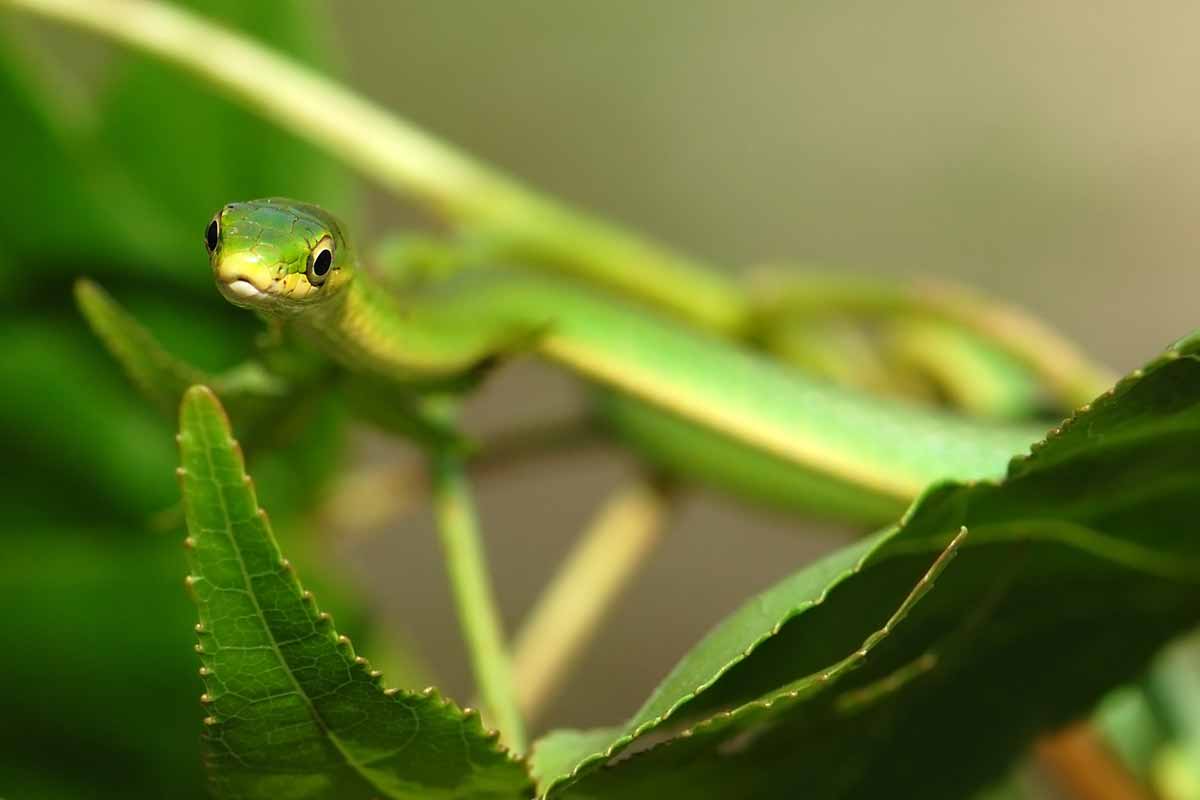
Gather The Tools You’ll Need
Sturdy, leather gloves
to inspect, with care, areas you may think are harboring snakes
Flashlight
to see into dark areas
Long broom
to encourage the snake, if it is non-venomous, to leave
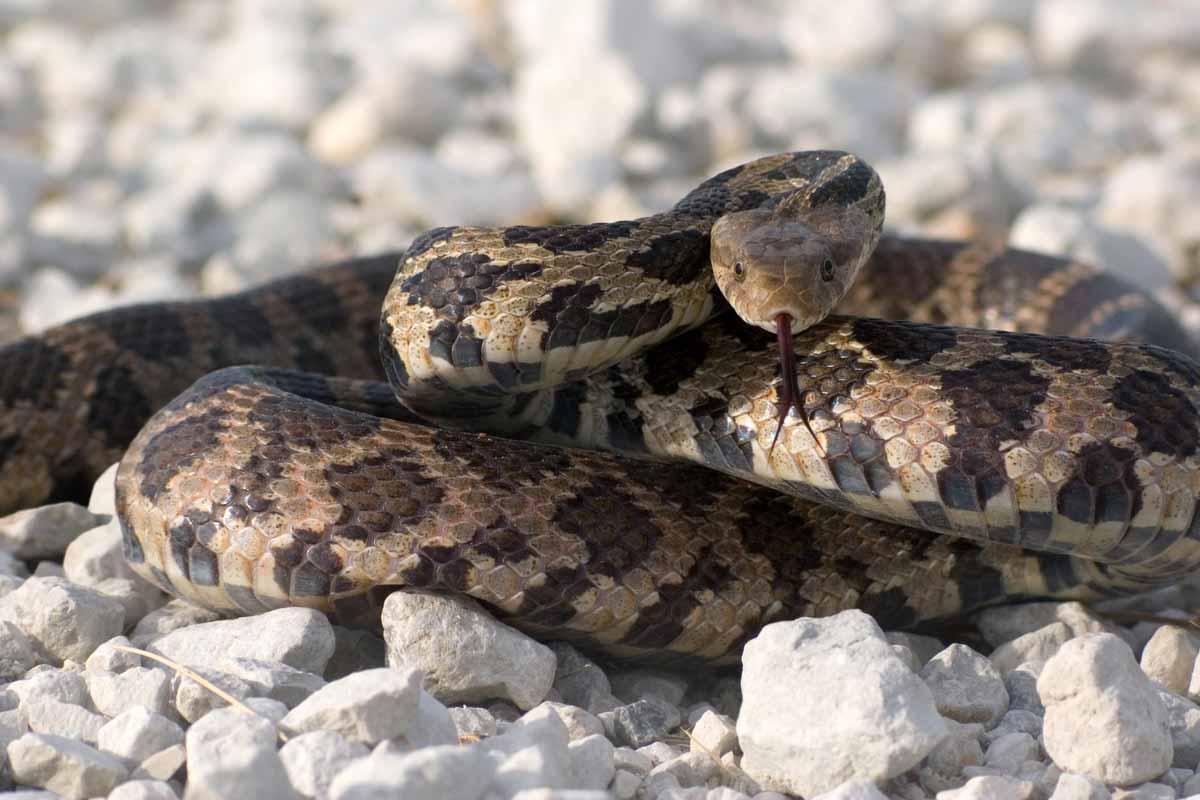
How To Steps For DIY Removal
If you are brave enough to attempt to get rid of a snake yourself, there are a few things you can try.
Sweep it away
If you’re 100 percent sure the snake is non-venomous, then you can use a push broom with a long handle and nudge it out of a house, garage or shed.
Set a trap
You can buy a trap at your local hardware or home improvement store, or you can purchase them online. They lure snakes in with features that mimic natural areas you would find a snake. Once they get in, the snake cannot get out.
Risks Of Disease
The biggest health risk snakes pose to humans is through bites. If a poisonous snake bites you, you need to remain calm, get away from and out of the snake’s striking distance and then call 911 immediately. While you wait for medical professionals to arrive or while you’re being driven to the emergency room, the Mayo Clinic Mayo Clinic says there are some things you need to do and not do.
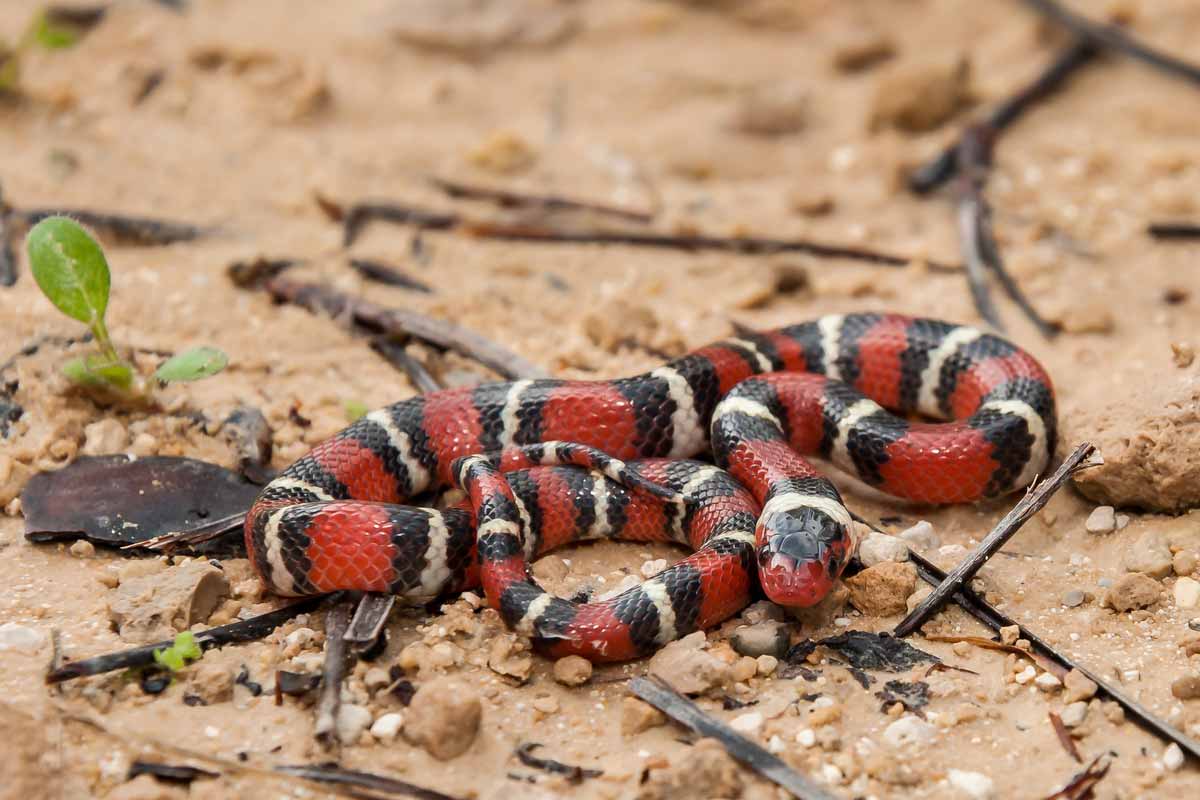
Do’s
- Remove any jewelry or tight clothing before you start to swell.
- If possible, position yourself so the bite area is at or below your heart.
- To keep the venom from spreading, stay as still as possible.
- Don’t flush it with water but clean the wound and cover it with a clean, dry dressing.
- Try to remember the colors and shape of the snake so that you can describe it.
Don’ts
- Don’t apply ice
- Don’t use a tourniquet
- Don’t cut the wound
- Don’t attempt to remove the venom
- Don’t drink caffeine or alcohol (It can speed up your body’s absorption of venom)
- Don’t try to capture the snake
Treating Your Property For Snakes
Snake Problem?
Within 15 to 30 minutes, you will develop a severe and burning pain at the site of a venomous snake bite.
Within 15 to 30 minutes, you will develop a severe and burning pain at the site of a venomous snake bite. Swelling and bruising at the wound will follow and can spread. For example, if a poisonous snake bit you on the hand, your whole arm may swell. You may also become nauseous and weak and develop an odd taste in your mouth. If a coral snake bit you, you might experience tingling, difficulty speaking and weakness.
You will be given an anti-venom at the hospital and will probably be admitted and kept for at least 24 hours, so doctors and nurses can monitor you. It can take several weeks or months to recover from a venomous snake bite.
Even non-venomous snake bites should receive immediate medical attention. The wound will need to be cleaned and bandaged correctly, and you may also need to get a tetanus shot.
You can contract salmonella by handling a dead snake or possibly a snake’s skin. It’s important to wash your hands thoroughly after you’ve disposed of it. Salmonella infections can last up to seven days, but it can take your body a few months to get completely back to normal. The symptoms include:
- Nausea
- Vomiting
- Abdominal cramps
- Diarrhea
- Fever
- Chills
- Headache
- Blood in stool
Snake Sounds
We tend to think that snakes only hiss and rattle, but they actually have a few surprises we hadn’t considered: they can issue a growl (different pitches per species), some can shriek, and they fart! Some snakes, when cornered, will force air through vents in their back ends resulting in multiple popping sounds, aka flatulence. But more than not, you’ll either hear a snake rattling through leaves (making the sounds even without an actual rattler) or hissing.
Snake Tracks
Snake tracks aren’t overly obvious unless you’re looking for them, or the terrain allows for them. Sand, mud, dirt, and soil are the best receptors for tracks to be found. Snake tracks, while clearly taking a ‘slithering’ motion, will either take on a side-winding, side-pushing, lateral undulation, or a scrunch-up-scrunch-out motion called ‘concertina’. Straight line tracks are generally made by larger and heavier species of snake.
Snake Poop
Snake poop is pretty mushy and and smooth, and will often contain undigested portions of what they’ve eaten, including bones and fur. When fresh, snake poop is dark brown in color, but will turn chalky as it dries out. It comes out oblong shaped, with a white liquid excretion of urea. The size of the poop will specify the size of the snake, and its contents indicate which species you’re dealing with.
Prevent
Prevention
The best defense against snakes is to keep them from wanting to come to your property in the first place. There are several things you can do to ensure the slithering serpents stay in the woods.

Clean it up
Wood piles, rock piles, trash piles, and junk piles are havens for snakes. Clean up these areas and dispose of everything properly.
Mow your yard
Keeping the yard mowed not only makes it look appealing, but it also keeps creatures out of your yard that you don’t want. Tall grass allows snakes to hide out, undetected. So, keep the yard mowed and you will be less likely to have snakes.
Keep the landscaping trimmed
Keeping your hedges, shrubs, and bushes trimmed will keep out a lot of unwanted animals. Rats, a favorite food of many snakes, and other rodents like to hang out in unkept landscaping—which could be an invitation for snakes to stop by for breakfast, lunch or dinner.
Fix gaps and holes
Do a thorough inspection of your home and look for any gaps or holes that may allow a snake to slither inside. They like dark, damp and cool areas. Pay special attention to gaps under exterior doors and crawl spaces. All they need is a space about the size of your finger. Fix any problem areas with professional construction equipment.
Check your foundation
Look for any cracks in the foundation of your home and seal them properly. You will also want to make sure you tightly seal the vents with vent screens.
Gather the eggs
If you raise chickens, make sure you gather the eggs regularly. Snakes like those eggs more than humans and once they discover you have them, they will return regularly to eat.
Install a snake fence
Wire mesh works bests. Install it a few inches into the ground to keep the snake from getting underneath it. Be sure and slope it outward at an angle to keep snakes or other animals from climbing over it.
Treating Your Property For Snakes
Snake Problem?
Snake Sounds
We tend to think that snakes only hiss and rattle, but they actually have a few surprises we hadn’t considered: they can issue a growl (different pitches per species), some can shriek, and they fart! Some snakes, when cornered, will force air through vents in their back ends resulting in multiple popping sounds, aka flatulence. But more than not, you’ll either hear a snake rattling through leaves (making the sounds even without an actual rattler) or hissing.
Snake Tracks
Snake tracks aren’t overly obvious unless you’re looking for them, or the terrain allows for them. Sand, mud, dirt, and soil are the best receptors for tracks to be found. Snake tracks, while clearly taking a ‘slithering’ motion, will either take on a side-winding, side-pushing, lateral undulation, or a scrunch-up-scrunch-out motion called ‘concertina’. Straight line tracks are generally made by larger and heavier species of snake.
Snake Poop
Snake poop is pretty mushy and and smooth, and will often contain undigested portions of what they’ve eaten, including bones and fur. When fresh, snake poop is dark brown in color, but will turn chalky as it dries out. It comes out oblong shaped, with a white liquid excretion of urea. The size of the poop will specify the size of the snake, and its contents indicate which species you’re dealing with.
When to Call a Professional
Unless you are 100 percent sure the snake you’re dealing with is non-venomous, it’s best to call a professional wildlife trapper to take care of any snake problem you may have. They are trained and know how to capture and dispose of a snake properly.
https://www.cdc.gov/niosh/topics/snakes/types.html
https://www.nationalgeographic.com/animals/reptiles/e/eastern-coral-snake/
https://www.livescience.com/43597-facts-about-water-moccasin-cottonmouth-snakes.html
https://www.livescience.com/43641-copperhead-snake.html
https://www.livescience.com/43683-rattlesnake.html
https://srelherp.uga.edu/snakes/crohor.htm
http://naturemappingfoundation.org/natmap/facts/western_diamondback_rattlesnake_k6.html
http://www.biokids.umich.edu/critters/Thamnophis_sirtalis/
https://www.livescience.com/53855-rat-snake.html
http://www.lihs.org/files/caresheets/Heterodon.htm
https://srelherp.uga.edu/snakes/colcon.htm
https://my.clevelandclinic.org/health/diseases/15647-snake-bites/management-and-treatment
https://www.mayoclinic.org/diseases-conditions/salmonella/symptoms-causes/syc-20355329
https://www.hgtv.com/outdoors/gardens/animals-and-wildlife/keep-snakes-out-of-your-garden
https://georgiawildlife.com/georgiasnakes
https://www.livescience.com/27845-snakes.html
https://snake-facts.weebly.com/timber-rattlesnake.html
https://nationalzoo.si.edu/animals/eastern-diamondback-rattlesnake
https://srelherp.uga.edu/snakes/croada.htm
https://www.desertmuseum.org/kids/oz/long-fact-sheets/Diamondback%20Rattlesnake.php
https://srelherp.uga.edu/snakes/agkpis.htm
https://srelherp.uga.edu/snakes/micful.htm
https://srelherp.uga.edu/snakes/agkcon.htm
https://www.in.gov/dnr/fishwild/9398.htm
https://srelherp.uga.edu/snakes/elaobs.htm
https://srelherp.uga.edu/snakes/hetpla.htm
https://srelherp.uga.edu/snakes/nersip.htm
Treating Your Property For Snakes
Snake Problem?
Sources
http://mentalfloss.com/article/68816/6-sssecrets-snake-sound-scientissst
https://www.wildernesscollege.com/snake-tracks.html
http://www.wildlife-removal.com/snakepoop.html
http://www.snake-removal.com/poop.html
Snake Sounds
We tend to think that snakes only hiss and rattle, but they actually have a few surprises we hadn’t considered: they can issue a growl (different pitches per species), some can shriek, and they fart! Some snakes, when cornered, will force air through vents in their back ends resulting in multiple popping sounds, aka flatulence. But more than not, you’ll either hear a snake rattling through leaves (making the sounds even without an actual rattler) or hissing.
Snake Tracks
Snake tracks aren’t overly obvious unless you’re looking for them, or the terrain allows for them. Sand, mud, dirt, and soil are the best receptors for tracks to be found. Snake tracks, while clearly taking a ‘slithering’ motion, will either take on a side-winding, side-pushing, lateral undulation, or a scrunch-up-scrunch-out motion called ‘concertina’. Straight line tracks are generally made by larger and heavier species of snake.
Snake Poop
Snake poop is pretty mushy and and smooth, and will often contain undigested portions of what they’ve eaten, including bones and fur. When fresh, snake poop is dark brown in color, but will turn chalky as it dries out. It comes out oblong shaped, with a white liquid excretion of urea. The size of the poop will specify the size of the snake, and its contents indicate which species you’re dealing with.




